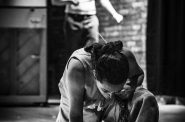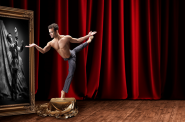Destiny, chance and circumstance
UWM's annual summer dance show, with faculty and guest choreographers and student dancers, tackles the big issues.

Kayla Schroepfer (aloft) and Katharina Abderholden. Photo by Pete Amland, courtesy of UWM Peck School of the Arts.
Destiny. Chance. Circumstance. Ambitious themes for young dancers, but UW-Milwaukee dance faculty and students carried them well in their annual Summerdances concert.
No doubt, the sudden and unexpected death of Ed Burgess, former chair of the dance department, pushed these ideas to the fore of his colleagues’ minds.
The Year of Unremarkable Laughter, choreographed by Colleen Thomas with dancers, was most explicitly tied to the evening’s theme and to Burgess’ untimely departure.
A jester (Kao Zhong Xiong), shuffling into the space a bit tardy because her watch was “two days late,” directed our attention to time and ambiguity. Quartets and duets of dancers – most notably a strong performance by Steven Michael La Fond and Jose A. Luis – carved the space, sometimes sharing weight, slowing and speeding with John McGrew’s curious ambient score.
In the middle of the piece, individual dancers broke out in rap, completing the thought: “Before I die, I wanna…” Be a dancer. Believe in God. Be ready to die.
McGrew’s minimalist lyrics repeated, “Waltz around me when I’m old.” Or was it, “All surround me when I go?” I’m not quite sure, but either conjures communion with a fading loved one. The dancers slowly pliéd in soft light, arms rising skyward, as a male dancer walked through them, then circled the group.
It was easy to feel Burgess nearby, urging us to think about how best to use our time here.
But beyond reminding us of him, destiny, chance and circumstance are also the raw materials with which choreographers create. Given the circumstances – bodies, technique, space, sound – they improvise and absorb what emerges by chance. They play with destiny, at once accepting and creating results.
Vanier’s actor-dancers all but screamed anxiety as they embodied it in various forms. Bob (Steven Moses) set the mood with a monologue that borrowed text from Panic: Origins, Insight and Treatment, by Brooke Warner and Peter A. Levine.
Enter Dance Teacher (Jaimi Patterson). A stereotypical eccentric artist, she worked desperately with – and against – her dancers to create something, as she said, “with meaning.” She was at once absorbed by the abstractness of modern dance and compelled by the control of a square-dance caller.
Absurdity gave way to humor as a voluptuous, rebellious dancer repeatedly knocked Patterson to the floor, and then kicked her around. The Dance Teacher was only encouraged, loving the “weight, the details, the rhythm!”
This was interwoven with bizarre scenes in which dancers enacted animals and recited a monologue with text from Jerusalem: The Emanation of the Giant Albion, by William Blake. I’m not entirely sure what this was about, but the mood – the confusion, the unease – seemed appropriate.
Dancers in Gerald Casel’s Adroit initiated fragmented movement by manipulating their own limbs and joints and those of others. The aesthetic was industrial and machine-like, but robots these were not. Thoroughly human, the dancers still bent, curled and interacted spontaneously. Adroit throughout, they revealed the vast potential in the relationship of one individual to another.
In one particularly beautiful solo, a woman spun in pirouette and then stopped suddenly, her hand outstretched as if waiting for a kiss, and then just as quickly took it back. A bit later, that same outstretched hand, fingers curled, found its place lightly on a male dancer’s shoulder.
Like Adroit, Elizabeth Johnson’s Impulsive Minors, set to piano music by Frederic Chopin, also had improvisational origins. The title’s double entendre was most evident in the work’s third section, “Siblings.” Three dancers experimented with weight sharing and partnering in all the creative, often humorous ways siblings play.
Inventive shapes and motifs, repeated, give the work a polished, cohesive feel. The audible stomping of a waltz meter, developed later as hands and feet struck the floor, had dancers playing the floor as Chopin played piano keys.
Christina Briggs Winslow’s Undertow juxtaposed intensity and silence, individuality and conformity. Dancers looked somewhat adolescent in Karmen Seib’s costuming – short, tight black dresses, some with denim tops, some with plaid shirts tied around the waist. This reinforced the angst that permates the piece.
At one point, four dancers left the stage and came down to the space in front of the audience. As individuals, they wavered between advancing and retreating. The lone dancer remaining on stage floundered exquisitely, with hands bound. These moments, along with the juxtapositions, gave the feeling that the dancers wanted to say something, but couldn’t.
I grappled with Undertow and other dances in the show, as to what they were really saying. But I’m not entirely sure that messages were even the point. Destiny, chance and circumstance tend to be inexplicable.
Summerdances runs Thursday, May 31 through Saturday, June 2, 7:30 p.m. at the UW-Milwaukee Mainstage Theatre, 2400 E. Kenwood Blvd. Select choreographers will give a pre-show talk at 6:45 p.m. every night. A reception will follow Friday’s show. Tickets are $17.00 general; $12.00 seniors, UWM faculty, staff & alumni; and $10 student. To reserve tickets, call the box office at 414-229-4308 or visit the Peck School of the Arts website.
Dance
-
Milwaukee Ballet Brings Back Orchestra
 Jul 14th, 2025 by Bruce Murphy
Jul 14th, 2025 by Bruce Murphy
-
New Riverwest Company, Production Impresses
 Feb 10th, 2020 by Brendan Fox
Feb 10th, 2020 by Brendan Fox
-
Milwaukee Ballet Show Remakes History
 Feb 10th, 2020 by Catherine Jozwik
Feb 10th, 2020 by Catherine Jozwik



















